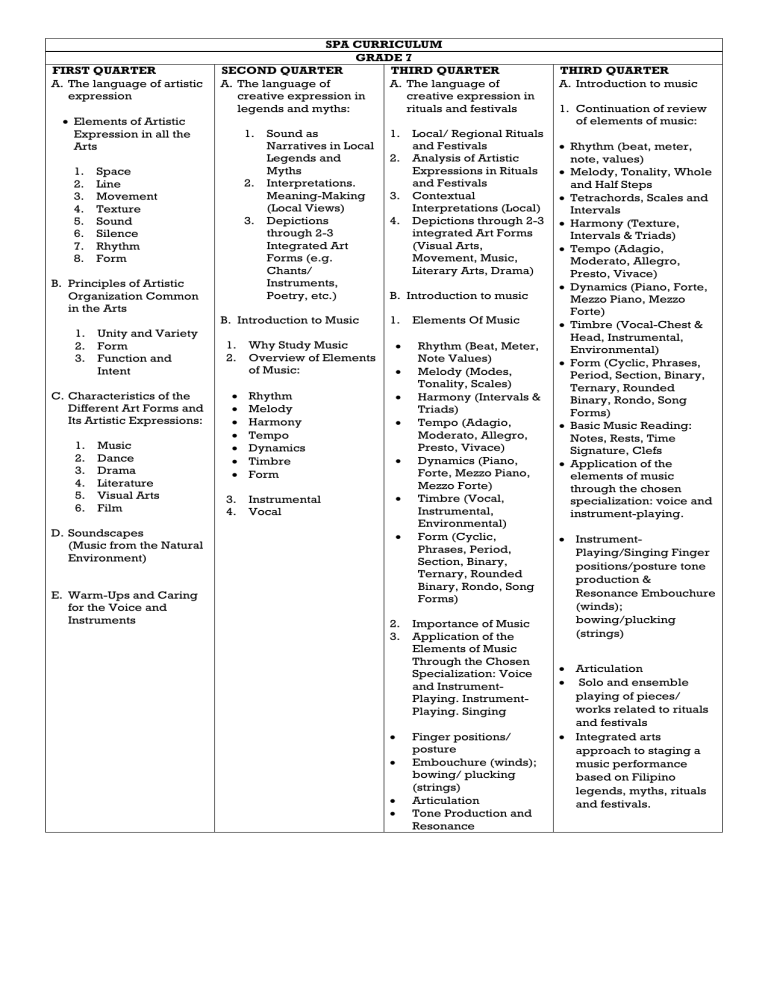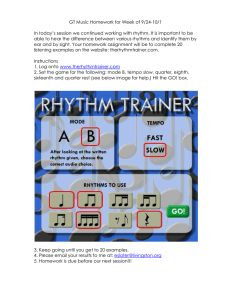
FIRST QUARTER A. The language of artistic expression SPA CURRICULUM GRADE 7 SECOND QUARTER THIRD QUARTER A. The language of A. The language of creative expression in creative expression in legends and myths: rituals and festivals Elements of Artistic Expression in all the Arts 1. 2. 3. 4. 5. 6. 7. 8. Space Line Movement Texture Sound Silence Rhythm Form B. Principles of Artistic Organization Common in the Arts 1. Unity and Variety 2. Form 3. Function and Intent C. Characteristics of the Different Art Forms and Its Artistic Expressions: 1. 2. 3. 4. 5. 6. 1. Sound as Narratives in Local Legends and Myths 2. Interpretations. Meaning-Making (Local Views) 3. Depictions through 2-3 Integrated Art Forms (e.g. Chants/ Instruments, Poetry, etc.) Music Dance Drama Literature Visual Arts Film D. Soundscapes (Music from the Natural Environment) E. Warm-Ups and Caring for the Voice and Instruments B. Introduction to Music 1. Why Study Music 2. Overview of Elements of Music: 1. Local/ Regional Rituals and Festivals 2. Analysis of Artistic Expressions in Rituals and Festivals 3. Contextual Interpretations (Local) 4. Depictions through 2-3 integrated Art Forms (Visual Arts, Movement, Music, Literary Arts, Drama) B. Introduction to music 1. Elements Of Music Rhythm Melody Harmony Tempo Dynamics Timbre Form 3. Instrumental 4. Vocal Rhythm (Beat, Meter, Note Values) Melody (Modes, Tonality, Scales) Harmony (Intervals & Triads) Tempo (Adagio, Moderato, Allegro, Presto, Vivace) Dynamics (Piano, Forte, Mezzo Piano, Mezzo Forte) Timbre (Vocal, Instrumental, Environmental) Form (Cyclic, Phrases, Period, Section, Binary, Ternary, Rounded Binary, Rondo, Song Forms) 2. Importance of Music 3. Application of the Elements of Music Through the Chosen Specialization: Voice and InstrumentPlaying. InstrumentPlaying. Singing Finger positions/ posture Embouchure (winds); bowing/ plucking (strings) Articulation Tone Production and Resonance THIRD QUARTER A. Introduction to music 1. Continuation of review of elements of music: Rhythm (beat, meter, note, values) Melody, Tonality, Whole and Half Steps Tetrachords, Scales and Intervals Harmony (Texture, Intervals & Triads) Tempo (Adagio, Moderato, Allegro, Presto, Vivace) Dynamics (Piano, Forte, Mezzo Piano, Mezzo Forte) Timbre (Vocal-Chest & Head, Instrumental, Environmental) Form (Cyclic, Phrases, Period, Section, Binary, Ternary, Rounded Binary, Rondo, Song Forms) Basic Music Reading: Notes, Rests, Time Signature, Clefs Application of the elements of music through the chosen specialization: voice and instrument-playing. InstrumentPlaying/Singing Finger positions/posture tone production & Resonance Embouchure (winds); bowing/plucking (strings) Articulation Solo and ensemble playing of pieces/ works related to rituals and festivals Integrated arts approach to staging a music performance based on Filipino legends, myths, rituals and festivals. FIRST QUARTER A. Introduction to the natural and cultural heritage of a community 1. Cultural heritage 2. The different dimensions of society: Ecology, Governance, Cultural, Social, Human, Economic and Spiritual 3. Assessing the music resources of a community 4. Basic social mapping B. Introduction to music: 1. Elements of music: Rhythm (simple & compound meter, syncopated) Melody (key signatures, scale degree names types and qualities of intervals) Harmony (chord functions, tonic, dominant, chord progressions) Tempo (grave, lento, prestissimo, ritardando, accelerando, rubato) Dynamics (crescendo, decrescendo, diminuendo) Timbre (HorboestelSachs classification, Voice-SATB), solo, duet, trio, quarter) Form (canon, fugue, sonata, allegro, concerto, symphony) 2. Importance of music As an expression of life As a tool for communication As an expression of personal and cultural identity As an expression of history As a repository if values As a means for promoting personal and social growth Instrument-Playing/ Singing Finger Positions/Posture Tone production & Resonance Embouchure Articulation Sight singing Basic sight reading Repertoire study SPA CURRICULUM GRADE 8 SECOND QUARTER THIRD QUARTER A. Our life sources A. Our cultural heritage Cultural mapping of 1. Ecological Mapping: cultural resources: Creative Presentation tangible and of Local Natural intangible using Resources (marine, creative integrated terrestrial, aerial arts approaches ecosystems of a community) B. Introduction to music 2. Earth music fusion 1. Elements of music Rhythm B. Introduction to Music Melody 1. Elements of Music Harmony Rhythm Tempo Melody Dynamics Harmony Timbre Tempo Form Dynamics Timbre 2. Application of the Form elements of music 2. Applications of the through the chosen Elements of music specialization: voice through the chosen and instrumentspecialization: voice playing and instrumentplaying. Instrument-Playing/ 3. InstrumentSinging Playing/Singing Finger positions/ (continuation from posture Grade 7) Tone production & Finger resonance positions/posture Embouchure Tone production & Articulation resonance Sight Singing Embouchure Basic sight reading Articulation Repertoire study Sight singing Choral harmony, Basic sight reading balance & blending Repertoire study Choral harmony, 3. Technique Class balance & blending (voice and instrument): performance of local music pieces 4. Cultural research Field Research approaches creating cultural heritage maps and selecting icons for music performance. Performance of pieces with cultural heritage content THIRD QUARTER A. Music performance on life sources and cultural heritage 1. Intro to music Analysis The identification of features played in a short heritage piece. The features would relate to the elements of music. B. Program planning Basics of planning a music performance Rehearsal preparation Staging the performance C. Rehearsals and performance: plays and/or music performances pertaining to life sources, heritage and culture.



